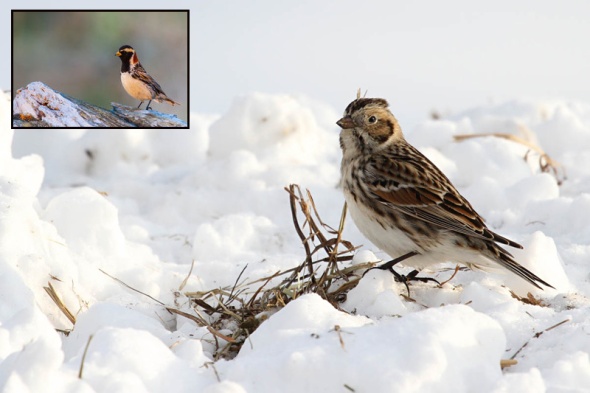Snow Buntings Starting To Head North
 Flocks of Snow Buntings have been observed more frequently lately, perhaps because male buntings have begun their migration back to their nesting grounds on the tundra. They are the first migrants to arrive in the Arctic in the spring (in early April), when it can be -20°F. Females arrive four to six weeks later, when days are warming and snow is beginning to melt.
Flocks of Snow Buntings have been observed more frequently lately, perhaps because male buntings have begun their migration back to their nesting grounds on the tundra. They are the first migrants to arrive in the Arctic in the spring (in early April), when it can be -20°F. Females arrive four to six weeks later, when days are warming and snow is beginning to melt.
It is thought that the males’ early return is related to the fact that, unlike most Arctic songbirds, buntings nest in rock cavities, for which there is great competition. Deep inside narrow cracks, nesting buntings can largely avoid nest predation, but their eggs are susceptible to freezing and require longer incubation than eggs laid in the open. As a result, females remain on the nest throughout much of the incubation period and are fed by the males. This arrangement shortens incubation time and provides the eggs with constant protection from freezing temperatures. (Photo: can you find the lone Lapland Longspur?)
Naturally Curious is supported by donations. If you choose to contribute, you may go to http://www.naturallycuriouswithmaryholland.wordpress.com and click on the yellow “donate” button.
Lapland Longspur Plumage
 The Lapland Longspur, named for the unusually long claw on its hind foot, breeds in the Arctic tundra and overwinters near fields throughout the northern half of the U.S. in flocks numbering up to four million birds.
The Lapland Longspur, named for the unusually long claw on its hind foot, breeds in the Arctic tundra and overwinters near fields throughout the northern half of the U.S. in flocks numbering up to four million birds.
Lapland Longspurs have two distinctly different plumages, especially the males. Their winter plumage (see photo) is streaked brown and somewhat dull. However, in the summer, the male’s plumage is very dramatic (see insert). The back of his neck, or nape, is bright rufous orange and black feathers form a distinctive facial mask and bib, bordered by a white stripe.
Unlike most birds with different breeding and non-breeding plumages, longspurs molt only once per year, in the fall, into their non-breeding plumage. How can the males look so different in the breeding season if there isn’t a second molt? By spring, the outer tips of these feathers have worn off to reveal the males’ (and females’, but to a lesser degree) distinctive breeding plumage underneath. (Insert photo from public domain)
Naturally Curious is supported by donations. If you choose to contribute, you may go to http://www.naturallycuriouswithmaryholland.wordpress.com and click on the yellow “donate” button.
Sedge Seeds
 Over 500 species of sedges in the genus Carex are found in the U.S. – over half of the world’s total. The great majority of these perennial, grass-like plants grow in the moist soil of meadows, marshes and bogs, as well as in high altitudes. Sedges are often distinguished from grasses by their stem, which is typically triangular in cross-section (“sedges have edges”). The flowers of sedges, each surrounded by a bottle-shaped bract, or modified leaf called a perigynium, are clustered on spikelets. The tips of these bracts persist after the seeds have formed, giving the spikelets a prickly appearance.
Over 500 species of sedges in the genus Carex are found in the U.S. – over half of the world’s total. The great majority of these perennial, grass-like plants grow in the moist soil of meadows, marshes and bogs, as well as in high altitudes. Sedges are often distinguished from grasses by their stem, which is typically triangular in cross-section (“sedges have edges”). The flowers of sedges, each surrounded by a bottle-shaped bract, or modified leaf called a perigynium, are clustered on spikelets. The tips of these bracts persist after the seeds have formed, giving the spikelets a prickly appearance.
Because of their wide availability, the seeds are eaten by many kinds of wildlife, especially birds. Wild Turkeys, American Woodcock, Northern Cardinals, Horned Larks, Snow Buntings, Lapland Longspurs, ducks, rails, sparrows, redpolls and finches relish them. In the Northeast, Carex seeds, along with insects, are the most regular items in the diet of Ruffed Grouse chicks. Moose also occasionally feed on sedge seeds. (Photo: Longhair or Bottlebrush Sedge, Carex comosa)
Naturally Curious is supported by donations. If you choose to contribute, you may go to http://www.naturallycuriouswithmaryholland.wordpress.com and click on the yellow “donate” button.


















What Other Naturally Curious People Are Saying